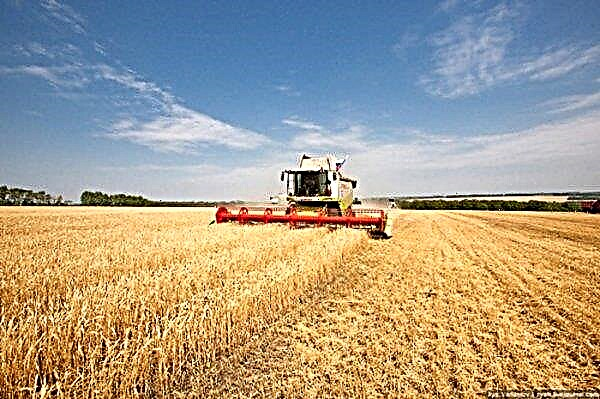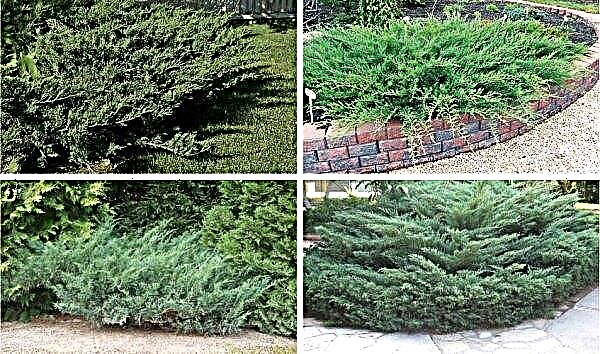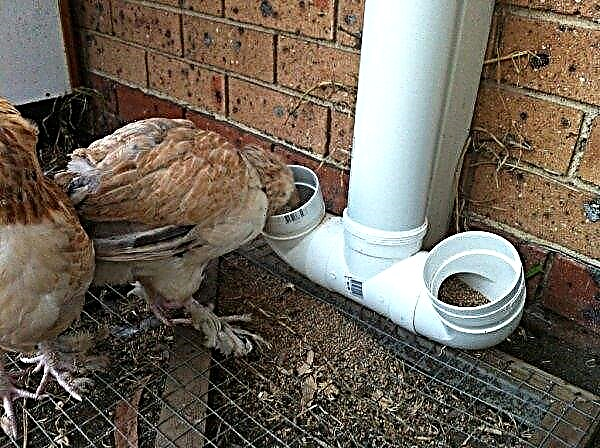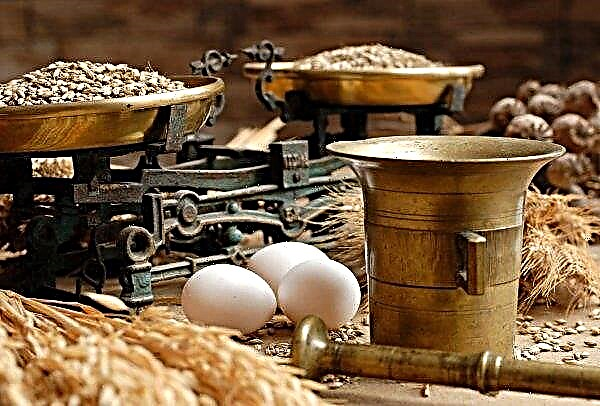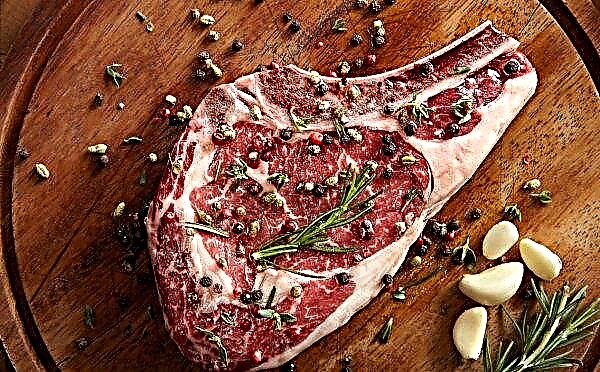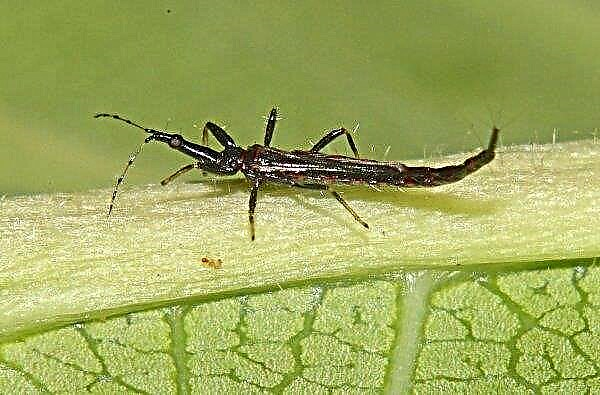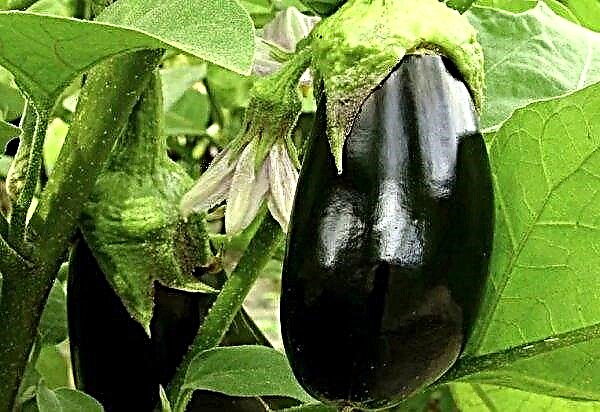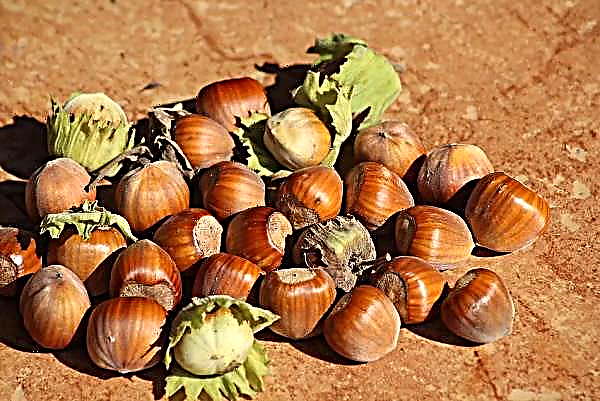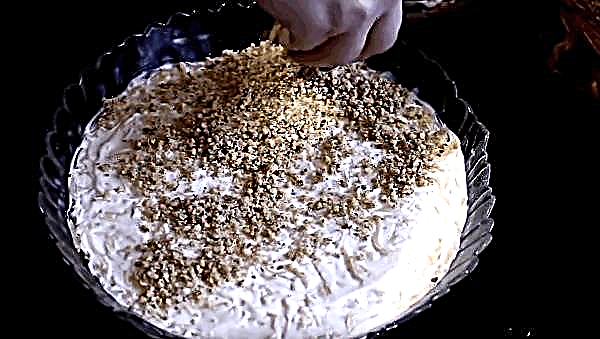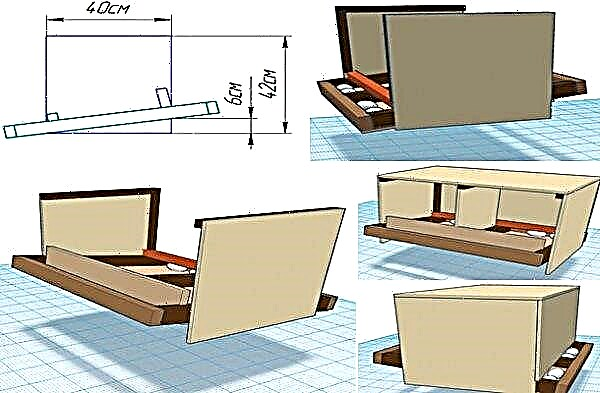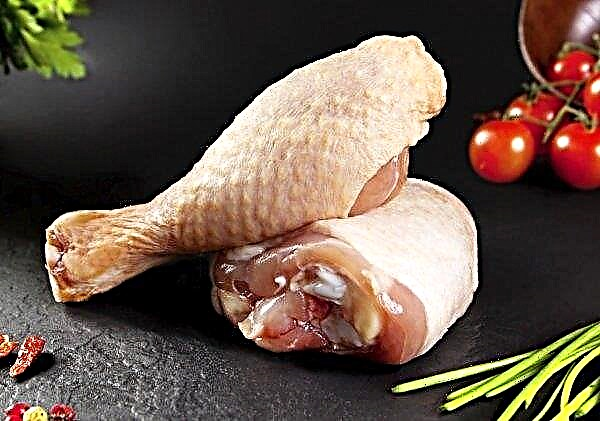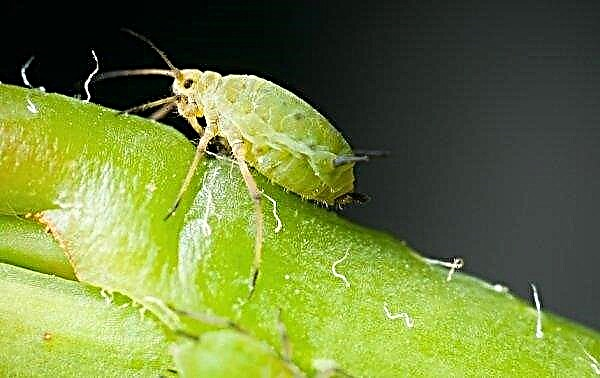There are several types of fir trees that can withstand difficult urban conditions: polluted air, man-made soil and unstable care. One of them is Belobok spruce - with lush blue needles and a conical crown. From the article you will learn how to properly plant and perform the basic procedures of agricultural technology for the use of wood in landscape design.
Botanical tree description
Spruce belongs to the genus of evergreen conifers of the Pine family. In total there are about 40 of their species with different heights, colors and crown shapes. Variety Belobok, or Bialobok (Picea pungens Bialobok) is a slow-growing decorative tree with blue needles.
 On average, by the age of ten, the width of the spruce reaches 2 m, and the height is 2.5 m.
On average, by the age of ten, the width of the spruce reaches 2 m, and the height is 2.5 m.
The tree receives a special decorative effect in early spring, when young light tips appear on top of the old dark shoots. Young shoots first acquire a creamy, then a bright creamy color, and after 5 weeks they “align” in color with last year's branches.
It is the contrast of blue and light that is the “trump card” of the variety. The shape of the crown can change during growth from hemispherical to conical. Cones with a male onset are large dark brown, and with a female - brown or red-brown up to 10 cm long.
The needles are dense and prickly, reaching a size of 3 cm. The tree has a wide root system with its surface arrangement. Spruce Belobok is unpretentious in maintenance and is patient with urban conditions, so designers prefer it for compactness, a spectacular combination of blue color with other plants and frost resistance.
Origin of name
There is an erroneous opinion that the name “Belobok” comes from the word “belobok” in connection with the unusual color of the tree. However, the facts indicate the opposite. Almost a century ago, in the 30s of the last century, the Polish gardener Jan Bialobok discovered a mutated specimen of needles.
Decorative appearance and compact size took their toll, so the gardener decided to keep the variety for use in landscape design, after which he began to be called the name of the breeder. Further research and propagation of prickly spruce were carried out in the area of the Polish city of Kournik.
Did you know? Spruce is the main supplier of volatile production - biologically active substances that can destroy pathogenic bacteria in the air, including tubercle bacillus. That is why specialized sanatoriums are built surrounded by conifers.
Landing
For planting a young plant, you should choose sunny or medium-shady areas with low groundwater. Despite the fact that the tree is shade-tolerant, with constantly incoming lighting, the color of its needles becomes brighter. However, during the plentiful spring sun, the young tree needs to be protected, since it is still sensitive to the abundance of bright light.
The best soil would be loamy or sandy loamy soil with an acid reaction.

Landing is recommended to be carried out in the spring, at the beginning of summer or in the fall, since at this time the root system develops especially actively, but if necessary, the procedure is also possible in winter. When group planting, the distance between the trees should be at least 2 m.
A step-by-step description of the procedure for planting spruce Belobok:
- Preparation of drainage, for which you can take sand, cracked brick, expanded clay, charcoal.
- Preparation of soil mixture from leaves, peat and sod land.
- Digging a hole with a diameter of root size and a depth of 50-60 cm.
- Backfill of drainage 20 cm thick.
- Irrigation of the landing site with 5 liters of water.
- The tree is placed in a pit so that the root neck is at ground level and the trunk is directed vertically.
- Filling the soil mixture and loosely compacting it.
- Digging a water blade along the diameter of the root with a width of 10 cm.
- Watering 40 liters of water, which equals 5-6 buckets.
- Fertilizing in the form of 100 g of Nitroammofoski or 10 g of Kornevin diluted in 10 liters of water.

A water dump is constructed so that the water is held as long as possible in the upper layer of the earth. This will help the soil fill all the voids in the root system of the tree.
Important! The near-stem circle must be mulched with compost in a dense layer over time. This will not only enrich the earth and fill it with useful elements, but also allow it to fully absorb moisture and maintain optimal temperature.
Spruce care
Spruce Belobok does not belong to demanding trees, however, it also needs timely care, which is to adhere to the rules of agricultural technology (for example, with excessive watering, the needles can become a victim of root rot, which will then spread to neighboring plants, and if the vitamins are insufficiently received, weaken and lose immunity against pests).

It is important to constantly monitor the condition of the earthen coma, which should not be wet and dry. That is why, when planning the use of blue spruce in the landscape design of a home site, it is better to purchase seedlings in a garden center or in specialized stores where attentive and timely care of plants is performed.
In urban conditions, caring for a tree and creating an irrigation regime is carried out in advance, and in the event of a deviation of the state of the plants from the norm, recommendations for their resuscitation are transmitted to the service workers.
Watering and feeding
Blue spruce prefers moderate watering, which does not form stagnation of water in the root system and does not create an earthen stone with a lack of moisture. During periods of drought, it is important to water the tree once a week, adding about 10 liters of water. Watering is done not under the root, but around the root coma, at a distance of 30 cm from the trunk.
To determine the need for moisture, take a handful of earth from under the tree and squeeze it in a fist, if it is dry and loose - you need watering, wet - it should be postponed until it dries. Water should be warm., since at below +12 ° C it adversely affects soil microorganisms, and in time it is better to choose morning or evening. In urban conditions, needles need periodic washing.

Spruce Belobok is afraid of an excess of fertilizers, which can lead to:
- rapid growth in excess of the norm;
- lignification of the lower branches;
- development is not up, but in breadth.
Therefore, fertilizers are applied only the first 5 years in the period of "growing up". After this, top dressing stops along with the growth of the tree, as a result of which a decorative compact spruce remains on the plot. Fertilize the plant twice a season (in early spring and mid-summer), without using manure and nitrogen components. Complex and mineral fertilizers, superphosphate will have the most favorable effect.
Important! Choose top dressing with magnesium content, since it is this component that is responsible for the photosynthesis of needles and its saturated color.
Organic is also useful for a young tree, which is introduced in the form of compost, biohumus. They nourish the soil with useful components and contribute to their better absorption by the roots of the plant. In urban plantings, it is difficult to pay attention to each tree, introducing organic fertilizing, therefore, for the treatment of large-scale or group plantings, a specialized complex additive in the form of "Kalimagnesia" is used.

Loosening and mulching
Loosening is an indispensable item in the care of any spruce. Due to the fact that it has a superficial root system, moisture and vitamins do not stay in the roots and go to the soil. In order for the tree to receive the maximum of useful substances, the first 2-3 years, twice a season, a surface digging is carried out along the diameter of the root coma with a depth of 10 cm.
Check out

This type of treatment increases the flow of air into the soil without turning over the earth and destroys the soil crust containing weed roots. Regardless of age, mulching of the root surface of the trunk with a thick layer at a distance of 50–80 cm is performed annually.
The procedure will create an optimal temperature for the roots, enrich the soil with minerals, retain moisture and create a favorable environment for the development of beneficial microorganisms.
Mulch, laid in early spring, is prepared from:
- peat moss - improves the structure of the soil, allowing mineral fertilizers not to be washed for a long time;
- compost - supports soil microflora, increases the activity of enzymes;
- chopped tree bark - reduces the rate of evaporation of water, inhibits the growth of weeds.
 The latter option is often used in urban landings, because it also has a design effect. In the case of the use of peat, its remnants are not removed the next year, but mixed with land and fresh is added.
The latter option is often used in urban landings, because it also has a design effect. In the case of the use of peat, its remnants are not removed the next year, but mixed with land and fresh is added.
Pruning
Under natural conditions, Belobok spruce does not need pruning, but if we are talking about flower beds, terraces, urban plantations and hedges, then it is necessary to observe the formation of the crown and conduct timely sanitary care.
Check out

It is recommended to do this for the first 8 years, then the tree “remembers” the shape and needs pruning only in case of pest invasion.
The procedure is performed with tools processed in Bacillol or Farmayode in late spring or early summer, after a period of active sap flow.
To do this, take a pruner, scissors (for hedges) or a brush cutter. First, dry and yellowed parts are removed, then live branches are cut off to form a crown.
It is advisable to avoid creases of needles, which after damage turns brown, affecting the appearance of the tree. Slices are treated with a carbon solution, garden var, potassium permanganate or other intended preparations. The procedure activates the lateral branching, makes the crown lush and dense, increasing its decorativeness.

Even insignificant pruning is stress for the tree, because after the procedure it weakens and loses immunity. For this reason, after a few days it is advisable to spray with drugs from pests and diseases, as well as with complex means with a high content of trace elements for plant health.
Important! Deep pruning and removal of more than a third of the growth of young branches can be painfully tolerated by Belobok spruce.
Possible diseases and pests
The juice of the needles is tasty and sweet, so it becomes a desirable habitat for insects, many of which harm it. Spruce Belobok can easily lose its attractive appearance when defeated by pests, which must be combated immediately.
All parasites can be divided into several types:
- sucking;
- gnawing;
- stem.
The former, as the name implies, feed on the juice of needles, sucking out life-giving moisture and useful substances from it. These include spider mites, shields, hermes, aphid and worms. You can recognize the defeat by sucking pests by the small sticky web that borders the branches, the yellow shade of the needles and their shedding, the bending of needles, thickening of shoots, abnormal growths.

The second group of parasites is given out by gnawed places, eaten kidneys, painted in the dark brown color of the side. Represents her purple sawfly, caterpillars, butterflies, mole. If a net of small holes is seen on the trunk of the Belobok spruce, this is the first sign of stem parasite damage. They can be barbel, bark beetles, crackers. They multiply rapidly and as a result of their activity, the needles become dull, turn yellow and quickly fall off.
Insecticides are used to control insects. ("Actofit", "Entocide"), fungicidal agents are used for fungal infections ("Topaz", "Fital"), and against mites should choose acaricidal solutions ("Blaster", "Vertimek"). In case of gnawing pests, it is necessary to dig up the area around the trunk, removing the nests of the larvae.
The use of wood in landscape design
In urban design, Belobok spruce is used in flower beds, alpine compositions, hedges in combination with stones and ponds. This variety looks spectacular at any time of the year and contrasts with other plants.. In spring, white brushes look beautiful against the background of the first green, and blue branches in winter are interestingly in harmony with snow.

The tree is popular with designers and gardeners due to its compactness, the ability to control growth, crown formation and a combination of different coniferous shades when creating mixborders. In rock gardens and rockeries, blue needles are often combined with bright colors: dolphinium, iris, peonies, cyclamen, periwinkle, armeria.
Against the background of spruce Belobok, bells, snowdrops, lilies of the valley, tulips, and crocuses look advantageous. From decorative deciduous plants choose volzhanka, hosta, coleus and others. In the landscape composition, spruce is the basis of the idea, for which a position is selected, and then shading plants.

The position of the tree may be:
- in front - combine with high perennials;
- in the middle - for mixed undersized stands;
- behind - next to plant onion flowers, weaving shrubs and plants with a bright color.
Cereals are beautifully in harmony with blue needles, and lilies or water lilies can be placed in a reservoir. From other trees, it is preferable to plant firs of other shades, maple, chestnut. Plants that cannot tolerate the high acidity resulting from fallen needles are not recommended to be planted nearby.
Did you know? North America is considered to be the birthplace of blue spruce, where it grows on the mountain slopes. From there, it was brought into the Russian Empire in the middle of the 19th century, after which the male and female cones were transported to different parts of the state.
In addition to the fact that conifers have unique properties, being the main generators of clean air, which is so necessary in urban conditions, thanks to their spectacular appearance, they occupy a central place in landscape arboretums. Blue spruce, including the Belobok variety, is especially appreciated for its unpretentiousness in care and the ability to create original tinted compositions.

